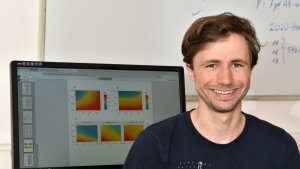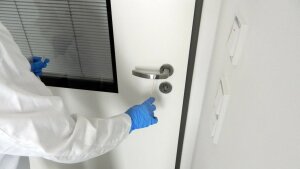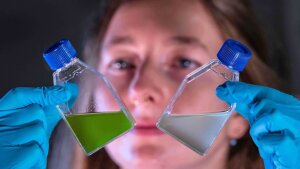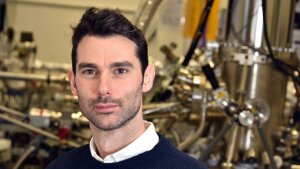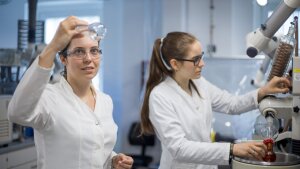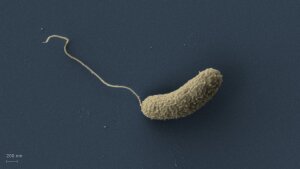Ticker
Jena scientists have succeeded in extending the life of lithium metal batteries.
Image: Sathish Rajendran/Wayne State UniversityLithium metal batteries improved
The energy density of traditional lithium-ion batteries is approaching a saturation point, but lithium-metal batteries can provide much more energy per unit weight. However, their widespread use is currently hindered by the formation of lithium dendrites—small, needle-like structures, similar to stalagmites in a dripstone cave, that grow over the lithium metal anode. Jena scientists led by Prof. Dr Andrey Turchanin, together with colleagues from Boston and Detroit, have now succeeded in preventing dendrite formation and thus at least doubling the lifetime of a lithium metal battery. The researchers reported on their method in the renowned journal »Advanced Energy Materials«. DOI: 10.1002/aenm.202100666External link [sh]
Julian Kauk investigated the spread of conspiracy myths in social networks.
Image: Anne Günther (University of Jena)Contagious conspiracy myths
Psychology Master's student Julian Kauk (photo) investigated how conspiracy myths about COVID-19 spread in social networks and published his research results in the scientific journal »PLOS ONE« (DOI: 10.1371/journal.pone.0256179External link). Using an epidemiological model for calculating the course of infectious diseases, he was able to show that the same mathematical models can describe biological and psychological »courses of infection«. Fact-checking has proven to be an effective means of containing the myth infection. However, this countermeasure loses its power the more widespread the theory has already become. Less successful, but effective regardless of time, is the removal of fake news. [viv]
A research team led by Hortense Slevogt studied how bacteria colonize rooms in a hospital building.
Image: AG Host Septomics/UKJHow microbes invade hospital rooms
A research team from Jena and Berlin led by Prof. Dr Hortense Slevogt studied for more than half a year how bacteria colonize rooms in a new hospital building. At the door handle, in the sink and on the floor, the germs carried into the room by people develop a characteristic spectrum of species. Among them are also pathogens, but their quantity remains relatively constant. In the study published in the journal »Microbiome« (DOI: 10.1186/s40168-021-01109-7External link), the authors also examined the bacteria present for gene sequences that mediate resistance to antibiotics. While there were only a few positive findings on door handles and in sinks, the resistance genes found on the floor increased over time. Further studies must show why this is so and how resistance genes are transmitted. [vdG]
Researchers at the University of Jena discovered a bacterial toxin that causes the algae to go blind.
Image: Jens Meyer (University of Jena)Bacterial toxin blinds algae
Researchers at the University of Jena have discovered a bacterial toxin that destroys the colour pigments in the eyespot of the single-cell green algae Chlamydomonas reinhardtii. Together with another toxic substance, the bacteria of the species Pseudomonas protegens not only disorientate and immobilize the green algae, but also condemn them to a certain death. The research team detected the toxin called »protegencin« with the help of Raman spectroscopy and natural product research. They published their study results in the scientific journal »PNAS« (DOI: 10.1073/pnas.2107695118External link). The researchers led by Prof. Dr Maria Mittag and doctoral candidate Vivien Hotter (photo) found that the green algal culture loses its colour almost completely overnight in the presence of the bacteria (pictured right). At the same time, the toxin dissolves the cell membrane of the algae. [US]
Jena physicists and chemists led by junior professor Giancarlo Soavi developed a method for the efficient modulation of laser light.
Image: Anne Günther (University of Jena)Efficient frequency doubling
With methods of nonlinear optics, it is possible to double the frequency of a light beam. This makes it possible, for example, to generate laser beams with wavelengths (light colours) that are not available with conventional laser sources. In addition, significant applications lie in the field of photonic data transmission and quantum communication. In order to exploit the potential of this technology, the modulation of the laser must be as fast and efficient as possible. Jena physicists and chemists led by Prof. Giancarlo Soavi (photo) have developed a particularly effective method for this together with colleagues from the Politecnico di Milano. They reported on their success in the scientific journal »Nature Photonics« (DOI: 10.1038/s41566-021-00859-yExternal link). [sh]
The research team discovered the microbial community of purpose by analysing natural substances.
Image: Maren ErtingshausenMicrobes united against the enemy
The symbiosis with bacteria protects the fungus Mortierella verticillata against its predator—a nematode. The international research team led by Prof. Dr Christian Hertweck found out about this microbial community of purpose by analysing natural substances. They discovered a toxin in the fungus that is also produced in a very similar form by a bacterium. This made the team wonder, because it seemed very unlikely to them that organisms as different as fungi and bacteria would produce such similar natural substances. The researchers published the solution to this riddle in the scientific journal »PNAS« (DOI: 10.1073/pnas.2110669118External link): bacteria live in the fungal hyphae and produce the toxin that keeps the nematode away. [Monika Kirsch]
Small RNA and protein molecules regulate the metabolism and toxin production of cholera bacteria.
Image: Kai Papenfort/Liana Franke/Uni JenaSmall molecules with a dual function
How small RNA and protein molecules regulate the metabolism of cholera bacteria (photo) and the production of cholera toxin is reported by a research team led by Prof. Dr Kai Papenfort in the »EMBO Journal« (DOI: 10.15252/embj.2021108542External link). The researchers show that a single RNA molecule, called Vibrio cholerae dual RNA and protein (vcdRP), intervenes at two distinct levels in the metabolism of the cholera pathogen and thus controls its harmful effect. On the one hand, it inhibits the production of the cholera toxin. Secondly, this small ribonucleic acid itself takes on the role of genetic information and encodes the blueprint for a small regulatory protein. This protein in turn activates a central metabolic pathway that converts dietary carbon into energy and biosynthetic building blocks such as amino acids. [US]
Martin Hoffmann, from the bioinformatics team that has developed a new method for identifying natural substances.
Image: Jens Meyer (University of Jena)AI recognises new natural substances
More than a third of all medicines available today are based on active substances from nature. Such molecules occur in numerous plants, bacteria and fungi. However, making them usable as medicines is time-consuming, costly and labour-intensive. A team of bioinformaticians led by Prof. Dr Sebastian Böcker has now developed a method that enables much faster and easier identification of small active substance molecules. The method presented by the researchers in the journal »Nature Biotechnology« uses machine learning methods to determine the structure of the molecules contained in spectrometric data obtained during the analysis of biological extracts—and does so in a very short time (DOI: 10.1038/s41587-021-01045-9External link). The researchers expect that thousands of molecular structures can be clarified in this way in the coming years. [US]

